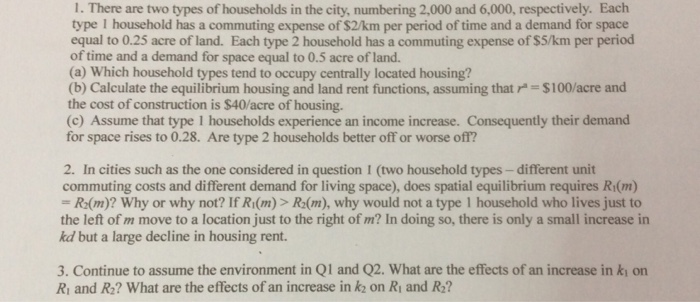1. There are two types of households in the city, numbering 2,000 and 6,000, respectively. Each type I household has a commuting expense of $2/km per period of time and a demand for space equal to 0.25 acre of land. Each type 2 household has a commuting expense of S5/km per period of time and a demand for space equal to 0.5 acre of land. (a) Which household types tend to occupy centrally located housing? (b) Calculate the equilibrium housing and land rent functions, assuming that S100/acre and the cost of construction is $40/acre of housing. (c) Assume that type 1 households experience an income increase. Consequently their demand for space rises to 0.28. Are type 2 households better off or worse off? 2. In cities such as the one considered in question I (two household types - different unit commuting costs and different demand for living space), does spatial equilibrium requires Ri(m) Rdm)? Why or why not? If R(m) > Rdm), why would not a type 1 household who lives just to the left of m move to a location just to the right of m? In doing so, there is only a small increase in kd but a large decline in housing rent 3. Continue to assume the environment in Q1 and Q2. What are the effects of an increase in ki on Ri and R2? What are the effects of an increase in k2 on Ri and R? 1. There are two types of households in the city, numbering 2,000 and 6,000, respectively. Each type I household has a commuting expense of $2/km per period of time and a demand for space equal to 0.25 acre of land. Each type 2 household has a commuting expense of S5/km per period of time and a demand for space equal to 0.5 acre of land. (a) Which household types tend to occupy centrally located housing? (b) Calculate the equilibrium housing and land rent functions, assuming that S100/acre and the cost of construction is $40/acre of housing. (c) Assume that type 1 households experience an income increase. Consequently their demand for space rises to 0.28. Are type 2 households better off or worse off? 2. In cities such as the one considered in question I (two household types - different unit commuting costs and different demand for living space), does spatial equilibrium requires Ri(m) Rdm)? Why or why not? If R(m) > Rdm), why would not a type 1 household who lives just to the left of m move to a location just to the right of m? In doing so, there is only a small increase in kd but a large decline in housing rent 3. Continue to assume the environment in Q1 and Q2. What are the effects of an increase in ki on Ri and R2? What are the effects of an increase in k2 on Ri and R







